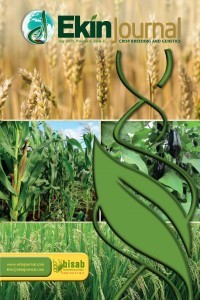Genetic Improvement of Tomato (Solanum lycopersicum L.) for Phytonutrient Content at AVRDC - The World Vegetable Center
Genetic Improvement of Tomato (Solanum lycopersicum L.) for Phytonutrient Content at AVRDC - The World Vegetable Center
Tomato is a widely consumed global vegetable and a major source of the phytonutrients vitamin C, beta-carotene
(provitamin A), lycopene, and flavonoids. Tomato cultivars with increased fruit phytonutrient density could help overcome
micronutrient malnutrition and contribute to better human health. It is important for plant breeders to understand the genetic
diversity and genetic control of targeted phytonutrients, the extent to which environmental factors such as temperature
or light intensity affect phytonutrient content, and whether altered phytonutrient content significantly affects yield and
horticultural or fruit quality traits. Tomato breeding at AVRDC - The World Vegetable Center has included phytonutrient
objectives in its breeding programs and has developed tropically adapted, high yielding and multiple disease resistant
lines with increased content of beta-carotene, lycopene, flavonoids, or anthocyanin in different fruit types. Increased
content of some phytonutrients such as lycopene is associated with better fruit quality. On the other hand, high betacarotene
content results in orange-fleshed fruit, which is not readily accepted by many consumers. AVRDC seeks to
popularize high phytonutrient tomato cultivars through linkages with organizations promoting nutrition and health.
Keywords:
Nutrition, beta-carotene lycopene,
___
- Bino RJ, de Vos CHR, Lieberman M, Hall RD, Bovy A, Jonker HH, Tikunov Y, Lommen A and Leven I (2005). The light-hyperresponsive high pigment-2dg mutation of tomato: alterations in the fruit metabolome. New Phytologist 166: 427-438. Bravo L (1998). Polyphenols: chemistry, dietary sources, metabolism, and nutritional significance. Nutr. Rev. 56: 317-333. FAO 2013. http://faostat3.fao.org/browse/rankings/ commodities_by_regions/E Hanson PM, Schafleitner R, Huang SM, Tan CW, Ledesma D and Yang RY (2014). Characterization and mapping of a QTL derived from Solanum habrochaites associated with elevated rutin content (quercetin-3-rutinoside) in tomato. Euphytica 200: 441-454. Hanson PM, Yang RY, Wu J, TChen J, Ledesma D, Tsou SCS and Lee TC (2004). Variation for antioxidant activity and antioxidants in tomato. Amer J Soc Hort Sci 129: 704-711 Jones CM, Mes P, Myers JR (2003). Characterization and inheritance of the Anthocyanin fruit (Aft) tomato. Hered J. 94: 449-456. Keatinge JDH, Yang RY, d’A Hughes J, Easdown WJ, and Holmer R (2011) The importance of vegetables in ensuring both food and nutritional security in attainment of the Millennium Development Goals. Food Sec 3: 491-501 Konsler TR (1973). Three mutants appearing in ‘Manipal’ tomato. HortScience 8: 331–333. Leiva Brondo M, Valcárcel M, Cortés-Olmos C, Roselló S, Cebolla Cornejo and Nuez F (2012). Exploring alternative germplasm for the development of stable high vitamin C content in tomato varieties. Scientia Horticul. 133: 84-88. Levin I, Frankel P, Gilboa N, Tanny S and Lalazar A (2003). The tomato dark green mutation is a novel allele of the tomato homolog of the DEETIOLATED1 gene. Theor Appl Genet 106: 454- 460. Muthayya S, Rah JH, Sugimoto JD, Roos FF, Kraemer K and Black RE (2013). The global hidden hunger indices and maps: an advocacy tool for action. PLOS One 8: e67860 Ronen G, Carmel Goren L, Zamir D and Hirschberg J (2000). An alternative pathway to β-carotene formation in plant chromoplasts discovered by map-based cloning of Beta and old-gold color mutations in tomato. Proc Nat Acad Sci 97: 111-2-1107. Ross JA and Kasum CM (2002). Dietary flavonoids: bioavailability, metabolic effects, and safety. Annu. Rev. Nutr. 22: 19-34. Sapir M, Oren Shamir M, Ovadia R, Reuveni M, Evenor D, Tadmor Y, Nahon S, Shlomo H, Chen L, Meir A, Levin I (2008). Molecular aspects of anthocyanin fruit tomato in relation to high pigment-1. J. Hered 99: 292-303. Stommel JR (2007). Genetic enhancement of tomato fruit nutritive value. In Razdan, M.K, Mattoo, A.K., (Eds.) Genetic Improvement of Solanaceous Crops Vol 2: Tomato. Science Publishers, Enfield NH, USA. pp. 193-238. Teucher B, Olivares M and Cori H (2004). Enhancers of iron absorption: ascorbic acid and other organic acids. Int. J. Vitam. Nutr. Res. 74: 403-419. Wann EV (1997). Tomato germplasm lines T4065, T4099, T5019, and T5020 with unique genotypes that enhance fruit quality. HortScience 32: 747–748. Yang RY, Hanson PM, Lumpkin TA (2007). Better health through horticulture - AVRDC’s approach to improved nutrition of the poor. Acta Hort. 744:71-77. Yen HC, Shelton BA, Howard LR, Lee S, Vrebalov J, Giovannoni JJ (1997). The tomato high-pigment (hp) locus maps to chromosome 2 and influences plastome copy number and fruit quality. Theor Appl Genet 95: 1069-1079.
- ISSN: 2149-1275
- Yayın Aralığı: Yılda 2 Sayı
- Başlangıç: 2015
- Yayıncı: Bitki Islahçıları Alt Birliği
